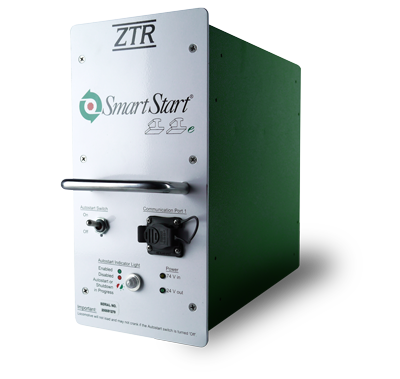The railway industry is already undergoing significant changes to become more efficient and sustainable. This shift is propelled by the adoption of advanced technologies like Automatic Engine Stop-Start (AESS) systems. These systems allow train operators to greatly improve the sustainability and efficiency of rail operations. This article delves into how SmartStart AESS systems are at the forefront of this important transformation. It emphasizes their vital role in initiating a major shift in the railway industry, which involves more than just shutting off the engine when it's not in use. By examining how these systems operate and their benefits, we uncover their potential to turn rail transport into an even more eco-friendly and energy-efficient option than before.
The Problem with Locomotive Idling
For years, the practice of leaving locomotive engines running while stationary has presented a significant challenge. This is partly because some engine functions critical to train operations, such as air brake pressure maintenance and battery charging, require the engine to be on. However, letting these engines idle for extended periods leads to excessive fuel consumption and contributes to environmental pollution through the emission of harmful gases. Recognizing the dual need to ensure trains operate efficiently and to reduce their ecological footprint, the railway industry is actively exploring advanced technological solutions. These solutions aim to optimize fuel use and minimize emissions without compromising the operational readiness of trains. Innovations in this area include the development of more efficient engines, systems that can automatically shut down engines when not needed, and alternative power sources that can reduce or eliminate the need for idling.
Exploring the Potential of AESS Technology
Idling reduction technology through Automatic Engine Start Stop (AESS) systems represents a cutting-edge approach to engine management, blending sophistication with practicality. SmartStart, standing out as an industry leader in this domain, has effectively harnessed advanced technology to forge solutions that not only promise fuel savings but also ensure compliance with stringent emission standards, thereby contributing to a healthier bottom line for companies.
At the heart of AESS technology is the capability to automatically shut down the engine when the locomotive is stationary, thereby reducing unnecessary fuel consumption and emissions. Conversely, the system is designed to instantly restart the engine as soon as the locomotive needs to move again, ensuring no delay in operations. This feature is particularly beneficial in maintaining operational efficiency without manual intervention.

What sets SmartStart AESS systems apart is their innovative design, which enables the system to intelligently distinguish between idle and operational states of a train. This discernment ensures that the engine is only running when absolutely necessary, maximizing fuel efficiency and reducing operational costs. Additionally, this sophisticated technology plays a crucial role in helping rail operators meet environmental regulations by significantly lowering the carbon footprint of locomotives.
The Benefits of Idling Reduction Technology
1. Reduced Fuel Consumption
A significant advantage of implementing AESS solutions is a substantial reduction in fuel consumption. With locomotive engines idling for up to 40% of their operational time, AESS technology can save up to 30% of total fuel usage. This not only leads to cost savings but also reduces the environmental impact of rail operations.
2. Emission Reduction
The reduction in fuel consumption also translates into a significant decrease in emissions. SmartStart AESS solutions can reduce greenhouse gas emissions by up to 33%, contributing greatly to the industry's efforts towards sustainability and environmental responsibility.
3. Compliance with Emission Standards
With increasingly stringent emission regulations, locomotive operators face pressure to comply with emission standards while maintaining operational efficiency. AESS technology helps meet these standards while also reducing
Spearheading Efficiency with AESS
Seamless Integration and Flexibility
SmartStart AESS systems seamlessly integrate with locomotives of varying makes, models, and ages, ensuring a smooth transition to more efficient operations. Whether it's older relay logic setups or modern microprocessor-equipped engines, SmartStart technology knows no discrimination.
Consistent Fuel and Energy Management
AESS isn't just about turning engines off; it's an intricate balancing act that ensures engines are at readiness without the wasteful idling periods. SmartStart systems not only manage engine start-up and shutdown but also provide detailed fuel management and savings verification, aligning railways with their financial and environmental targets effectively.
Environmental Solutions on Track
SmartStart commitment to reducing carbon footprints extends beyond just idling control. Their AESS systems are designed to meet the stringent EPA locomotive emission mandates, facilitating a significant reduction in harmful pollutants while promoting a greener operation.
Operational Excellence
SmartStart doesn't simply cut idle time; it also optimizes other locomotive system startups, leading to fuel and lube oil savings. The system also ensures that locomotives maintain operational readiness without unnecessary wear and tear, all while delivering the operational insights and fleet management capabilities necessary for steering a more efficient course.
Future-Forward Perspectives on Idling Reduction
As regulatory authorities tighten emission regulations, rail companies pivot towards corporate sustainability, and innovations such as Automatic Engine Start Stop (AESS) technology make significant strides, the trajectory of the rail industry is unmistakably leaning towards efficiency and environmental stewardship. SmartStart forward-thinking strategy epitomizes the perfect union of these objectives, offering a definitive roadmap to a sustainable and competitive future in rail.
AESS - A Keystone in Greener Railways
SmartStart AESS systems do more than just cut down on idle time; they mark a new era in how we manage locomotive operations. These systems create a scenario where caring for the environment and saving money go hand in hand. The rail industry, by adopting AESS technology, isn't just starting engines—it's moving towards a future where being efficient and sustainable is key to success on the tracks. Let's get behind AESS to push the rail industry towards being greener and more efficient.
Looking forward, reducing idle time with technology like AESS is crucial for the rail industry's sustainability and efficiency goals. But remember, AESS is just one part of a larger solution.